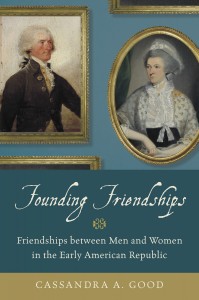 In the 1989 cult classic movie When Harry Met Sally, Harry says that in friendships between men and women, “the sex part always gets in the way.” This was precisely my concern when I began writing about friendships between men and women in the early American republic. How could I convince modern readers steeped in the When Harry Met Sally claim that friendships between men and women were impossible that the opposite was true, even 200 years ago?
In the 1989 cult classic movie When Harry Met Sally, Harry says that in friendships between men and women, “the sex part always gets in the way.” This was precisely my concern when I began writing about friendships between men and women in the early American republic. How could I convince modern readers steeped in the When Harry Met Sally claim that friendships between men and women were impossible that the opposite was true, even 200 years ago?
In my book, Founding Friendships: Friendships Between Men and Women in the Early American Republic, I argue that heterosocial friendships were not just possible, but important and meaningful relationships that challenge the ideology that marriage was the supreme place for adult fulfillment. Initially, I had hoped to skirt the issue of sexuality, but that was impossible. Sex did get in the way of these friendships, though not in the way you might think. The problem was more often with public misunderstandings about whether men and women were friends or lovers. It was a constant battle to shape perceptions. At another level, sex—or at least physical intimacy or simply flirtation—was a constant specter in these friendships.
I define heterosocial friendships as “affectionate, reciprocal relationships that the historical actors themselves cast in terms of a friendship” between unrelated men and women, with the stipulation that “sexual activity does not factor into this definition of friendship.” Historians simply cannot know what happened in a private room in the past. We do know from letters and diaries, however, that friends could express their affection in what sounds to modern ears like sensual or romantic terms and share physical intimacy.
One of the key resources for untangling the role of sexuality in these friendships was a 1989 article by sociologist Donald O’Meara titled “Cross-Sex Friendship: Four Basic Challenges of an Ignored Relationship.” I was stunned by how closely his observations of relationships of the 1980s applied to the friendships from the past that I examined. Friends had to navigate their shared understanding of the status of their relationship—was this a courtship, an affair, a friendship?—as well as the public perception. While the stakes for misunderstanding were higher 200 years ago, when gossip about a woman’s sexuality could destroy her reputation and marriage prospects, similar concerns have been remarkably persistent.
Some of my historical examples of the role of physical and sexual intimacy in heterosocial friendships sound familiar to modern readers. In 1834, Elizabeth Peabody recorded a conversation with her friend Horace Mann about “the difference between love and friendship” and where their relationship stood. Then there were teenage girls like Patty Rogers in 1785 who struggled to understand their feelings for men in their lives. Patty was determined when it came to one male friend: “I only feel a friendship for him! I’ll steel my heart to every sentiment of Love!” As O’Meara points out, there are different types of love which can be hard to distinguish and identify, and it can be hard for friends to come to a shared understanding. This continued to be the case for Patty, who protested when the same man put his hand on her breast one night. She told him it was inappropriate, but he protested “No, not between two friends!”
A major source of difficulty for historical figures and contemporary historians is the lack of clear norms for the conduct of heterosocial friendships. O’Meara argues that such friendships have “a deviant status in American culture” and “the norms for cross-sex friendship remain unclear.” The situation was little different in early America, despite the ubiquity of conduct books prescribing behavior. The primary difference is that the language early Americans used sounds romantic to us today but was understood quite differently in the past.
All of this meant that readers brought their own assumptions, beliefs, and ideologies to my book. One reviewer on Goodreads argued that the book was not actually about friendships, because “the vast majority of these friendships seem to wind up with somebody’s hands up somebody else’s petticoats.” At the opposite end of the spectrum, writer Thomas Fleming published a piece on History News Network positing that the book could be “the answer to our hookup culture” because the book showed that heterosocial friendships were possible, entirely absent of sex.
This major divide in reception of the book has been largely a divide between lay readers and scholars. Scholars, now steeped in a literature of sexuality that has usefully complicated notions of what relationships were possible in the past, readily accepted that heterosocial friendships were possible. Outside of academia, there seems to be a narrower lens for reading these relationships. Understanding that men and women could be friends hundreds of years ago, long before women’s liberation and acceptance of premarital sex, is important for Americans today. Along with the changed attitudes towards and legal climate for same-sex romantic relationships, we have greater possibilities for cross-sex friendships: The possibilities for varied types of love, sexuality, and fulfillment are broader than most people imagine.
Cassandra Good is a historian, writer, and teacher of early America. She received her PhD in history from the University of Pennsylvania and is Associate Editor of the Papers of James Monroe at the University of Mary Washington.
LINKS:
Founding Friendships: http://www.amazon.com/Founding-Friendships-between-American-Republic/dp/0199376174
Goodreads: https://www.goodreads.com/book/show/23027663-founding-friendships
O’Meara article: http://link.springer.com/article/10.1007%2FBF00289102
HNN article: http://historynewsnetwork.org/article/159632

Comments